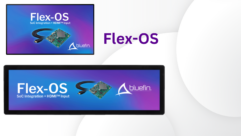
Picture This: SaaSy Digital Signage
Jun 4, 2009 4:02 PM,
By Jeff Sauer
Amid a recession, digital signage’s time has come.

One of the bright spots in today’s otherwise dark economic picture is a burgeoning digital signage market. According to a March 2009 study by ABI Research, the digital signage business—which, in ABI’s study, includes hardware, software, installation, and maintenance—is expected to grow by as much as 33 percent in 2009. That’s a truly encouraging, if not remarkable, number in these difficult times. It’s also a clear signal that digital signage’s time has come.
All along, digital signage has promised better, timelier communication ranging from targeted point-of-sale advertising to critical scheduling information at transportation hubs to simply a more efficient way to disseminate information across corporate and education campuses. While airports and arenas have been leveraging digital signs for a few years, digital signage is now reaching the broader business world—including much smaller organizations and establishments.
Related Links

The Buzz: Installation Spotlight: News Signage
The digital signage explosion has reached a point where electronic displays have seemingly penetrated every public space, including entertainment, retail, public safety, and transportation…

The Buzz: Installation Spotlight: POP Appeal
In 2008, the Wendy’s restaurant chain began the process of transitioning from static trans-light menu boards to dynamic digital menu boards in order to modernize many franchise and corporate-owned restaurants…

POV: Digital Signage Return on Investment
In a down economy, digital signage is a welcome growth technology in the AV market. Northern Sky Research has estimated that out-of-home digital display networks will generate $2.7 billion in advertising revenue by 2013…
What has changed? First, digital signage solutions have matured. Software has become more capable, more reliable, and better able to leverage wired and wireless IP networks—thereby cultivating more confidence in the market. An increasing number of successful case studies also now exist, offering guidance to those considering new digital signage installations. Second, hardware costs for flatpanels and player devices have also dropped considerably over the last couple of years, making the cost of entry for digital signage accessible for an increasingly broad market.
Yet digital signage remains complicated and a potentially expensive undertaking at a time when capital investment can be hard to rationalize. In many ways, the visible hardware is the easiest piece of a new digital signage puzzle because the costs are relatively straightforward and can be amortized over an understood period of time. It’s the rest of the digital signage infrastructure—the digital signage software, network management, and the creation of the signage content—that often raise more questions for new digital solution installations and more uncertainty about overall cost of ownership.
While shrewd businesspeople would argue that an economic slowdown is the best time to plan and expand for the future, it’s nonetheless difficult to pull the trigger when present circumstances are so unsettled. It’s no surprise then that there is growth in solutions that can reduce the initial capital investment.
Picture This: SaaSy Digital Signage
Jun 4, 2009 4:02 PM,
By Jeff Sauer
Amid a recession, digital signage’s time has come.
Software as a Service
As a general computer-industry initiative, software as a service (SaaS) has been around for more than a decade—and really since the early days of the Internet era. The concept of SaaS is to allow users to avoid the capital expense of purchasing software in favor of effectively renting it for the amount of time used. In very public rivalries, Oracle and Sun Microsystems made noise many years ago with SaaS office application suites that would compete with Microsoft Word and Excel. Admittedly, neither effort prospered due to the immaturity and relative low bandwidth of the erstwhile Internet. Microsoft-envy and animosity aside, the average computer user relies too much on word processing not to have a local version—particularly in light of the relatively low cost.
Yet as the Internet has become faster and more reliable, SaaS applications have become a lot more viable. Webmail is the most obvious and omnipresent, although that has more to do with the convenience of retrieving personal email anywhere than cost. There are also numerous other applications across a variety of vertical markets—as varied as architecture, CAD, retailing, and data storage—that embrace the SaaS concept for reasons of flexibility,functionality, and cost.
Digital signage SaaS applications are also gaining ground, with some obvious advantages compared to the conventional off-the-shelf software model. That begins with cost, although not necessarily in terms of the cost of the software itself. Case in point, Visix AxisTV SaaS solution requires a two-year upfront commitment. Although it’s payable monthly, thus reducing the upfront cost, it probably offers little savings over the cost of purchasing off-the-shelf software. However, like the aforementioned hardware costs, such specific software costs are calculable.
Digital signage initiatives tend to stall because it’s harder to predict the costs of the system buildout, network infrastructure and management, and creation and file management of the content. As the market for digital signage has expanded beyond the early adopters and into smaller retail, office, education, and house-of-worship environments, organizations are less likely to have personnel with the required IT and AV integration experience.
The benefit to many SaaS digital signage solutions is that the costs are effectively built into the usage costs, thereby removing the mystery of both cost and integration. SaaS applications such as Visix AxisTV can offer hosting services with a solid backbone infrastructure with network and file management as a part of the package, thereby removing much of the uncertainty associated with most digital signage projects. Like many SaaS offerings, AxisTV offers a web-based interface that offers users control of content assets, scheduling, and network options, but the company keeps it all on Visix servers and Visix’s network so the customer doesn’t need to have a dedicated administrator.
If customers need even more assistance, Visix even provides design and creative services for developing signage templates and, if necessary, the content itself. However, for the most part, the goal is to offer a solution that allows users to plug their own messages into an accessible template-based format.
Picture This: SaaSy Digital Signage
Jun 4, 2009 4:02 PM,
By Jeff Sauer
Amid a recession, digital signage’s time has come.
Visix is not the only major digital signage company to move into SaaS-based applications. Digital signage heavyweight Scala introduced a SaaS version of the Scala Content Manager earlier this year that similarly hosts customers’ content and scheduling material.
X2O Media takes a similar approach with its Software Plus Service strategy, combining X2O’s Xpresenter software with differing service options that allow customers to handle as much or as little of the infrastructure as they choose, or to increase their local buildout over time as they become more capable and as their internal digital signage initiatives become more successful. On the flip side, service-oriented companies such as BroadSign that once focused on custom digital signage content are moving toward SaaS models that give customers a greater role in managing their own digital signage.
In all of these SaaS cases, the service providers have realized the primary barriers that companies face as they evaluate digital signage possibilities. Particularly at a time when capital investment can be hard to justify, removing the cost and infrastructure unknowns can go a long way to allowing those potential customers to move forward and take advantage of new technology to improve their business, retail, or educational communication.









